Tiopronin
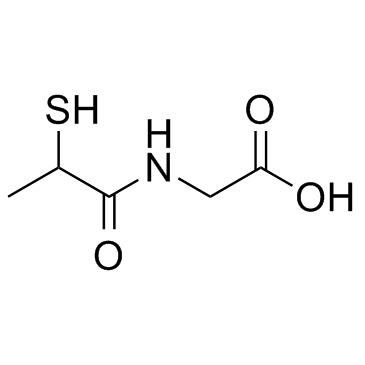
Tiopronin structure
|
Common Name | Tiopronin | ||
|---|---|---|---|---|
| CAS Number | 1953-02-2 | Molecular Weight | 163.195 | |
| Density | 1.3±0.1 g/cm3 | Boiling Point | 418.3±30.0 °C at 760 mmHg | |
| Molecular Formula | C5H9NO3S | Melting Point | 93-98 °C | |
| MSDS | Chinese USA | Flash Point | 206.8±24.6 °C | |
| Symbol |

GHS07 |
Signal Word | Warning | |
Use of TioproninTiopronin is a prescription thiol drug used to control the rate of cystine precipitation and excretion in the disease cystinuria.Target: OthersTiopronin is used primarily for cystinuria and is well known in the cystinuric community. Depending on the severity of a person's cystinuria, tiopronin may be taken for life, possibly starting in early childhood. It may also be used for Wilson's disease (an overload of copper in the body), and certain types of rare arthritis, though tiopronin is not an anti-inflammatory. Tiopronin is also sometimes used as a stabilizing agent for metal nanoparticles. The thiol group binds to the nanoparticles, preventing coagulation [1, 2]. |
| Name | Tiopronin |
|---|---|
| Synonym | More Synonyms |
| Description | Tiopronin is a prescription thiol drug used to control the rate of cystine precipitation and excretion in the disease cystinuria.Target: OthersTiopronin is used primarily for cystinuria and is well known in the cystinuric community. Depending on the severity of a person's cystinuria, tiopronin may be taken for life, possibly starting in early childhood. It may also be used for Wilson's disease (an overload of copper in the body), and certain types of rare arthritis, though tiopronin is not an anti-inflammatory. Tiopronin is also sometimes used as a stabilizing agent for metal nanoparticles. The thiol group binds to the nanoparticles, preventing coagulation [1, 2]. |
|---|---|
| Related Catalog | |
| References |
| Density | 1.3±0.1 g/cm3 |
|---|---|
| Boiling Point | 418.3±30.0 °C at 760 mmHg |
| Melting Point | 93-98 °C |
| Molecular Formula | C5H9NO3S |
| Molecular Weight | 163.195 |
| Flash Point | 206.8±24.6 °C |
| Exact Mass | 163.030319 |
| PSA | 105.20000 |
| LogP | -0.33 |
| Vapour Pressure | 0.0±2.1 mmHg at 25°C |
| Index of Refraction | 1.519 |
| Storage condition | -20°C Freezer, Under Inert Atmosphere |
CHEMICAL IDENTIFICATION
HEALTH HAZARD DATAACUTE TOXICITY DATA
|
| Symbol |

GHS07 |
|---|---|
| Signal Word | Warning |
| Hazard Statements | H302 |
| Personal Protective Equipment | dust mask type N95 (US);Eyeshields;Gloves |
| Hazard Codes | Xn |
| Risk Phrases | R22:Harmful if swallowed. |
| Safety Phrases | S36/37 |
| RIDADR | NONH for all modes of transport |
| WGK Germany | 3 |
| RTECS | MC0596500 |
| HS Code | 2942000000 |
|
~% 
Tiopronin CAS#:1953-02-2 |
| Literature: Vasilevskii,V.L. et al. Journal of Organic Chemistry USSR (English Translation), 1970 , vol. 6, p. 236 - 241 Zhurnal Organicheskoi Khimii, 1970 , vol. 6, p. 244 - 249 |
|
~% 
Tiopronin CAS#:1953-02-2 |
| Literature: Vasilevskii,V.L. et al. Journal of Organic Chemistry USSR (English Translation), 1970 , vol. 6, p. 236 - 241 Zhurnal Organicheskoi Khimii, 1970 , vol. 6, p. 244 - 249 |
|
~% 
Tiopronin CAS#:1953-02-2 |
| Literature: Oya; Matsumoto; Takashina; Iwao; Funae Chemical and Pharmaceutical Bulletin, 1981 , vol. 29, # 1 p. 63 - 70 |
|
~% 
Tiopronin CAS#:1953-02-2 |
| Literature: Oya; Matsumoto; Takashina; Iwao; Funae Chemical and Pharmaceutical Bulletin, 1981 , vol. 29, # 1 p. 63 - 70 |
| HS Code | 2930909090 |
|---|---|
| Summary | 2930909090. other organo-sulphur compounds. VAT:17.0%. Tax rebate rate:13.0%. . MFN tariff:6.5%. General tariff:30.0% |
|
Cheminformatics analysis of assertions mined from literature that describe drug-induced liver injury in different species.
Chem. Res. Toxicol. 23 , 171-83, (2010) Drug-induced liver injury is one of the main causes of drug attrition. The ability to predict the liver effects of drug candidates from their chemical structures is critical to help guide experimental... |
|
|
The Japanese toxicogenomics project: application of toxicogenomics.
Mol. Nutr. Food. Res. 54 , 218-27, (2010) Biotechnology advances have provided novel methods for the risk assessment of chemicals. The application of microarray technologies to toxicology, known as toxicogenomics, is becoming an accepted appr... |
|
|
Intermittent insulin treatment mimics ischemic postconditioning via MitoKATP channels, ROS, and RISK.
Scand. Cardiovasc. J. 49 , 270-9, (2015) It has previously been demonstrated that 15-min continuous insulin infusion at immediate reperfusion affords cardioprotection. This study sought to reduce the treatment time of insulin and test if int... |
| N-(2-Mercaptopropionyl)glycine |
| Sutilan |
| Thiopronine |
| EINECS 217-778-4 |
| Capen |
| SF-572 |
| UNII:C5W04GO61S |
| Thiosol |
| Thiora |
| Glycine, N-(2-mercapto-1-oxopropyl)- |
| Thiola |
| Tioglis |
| N-(2-mercaptopropanoyl)glycine |
| Epatiol |
| N-(2-Sulfanylpropanoyl)glycine |
| Tiopronin |
| N-2-Mercaptopropionyl-glycine |
| Vincol |
| 2-MPG |
| MFCD00004861 |
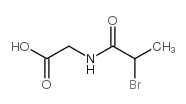
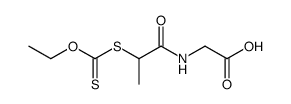

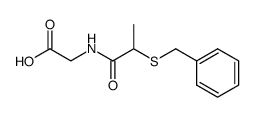
 CAS#:21709-90-0
CAS#:21709-90-0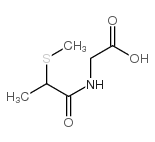 CAS#:87254-91-9
CAS#:87254-91-9
